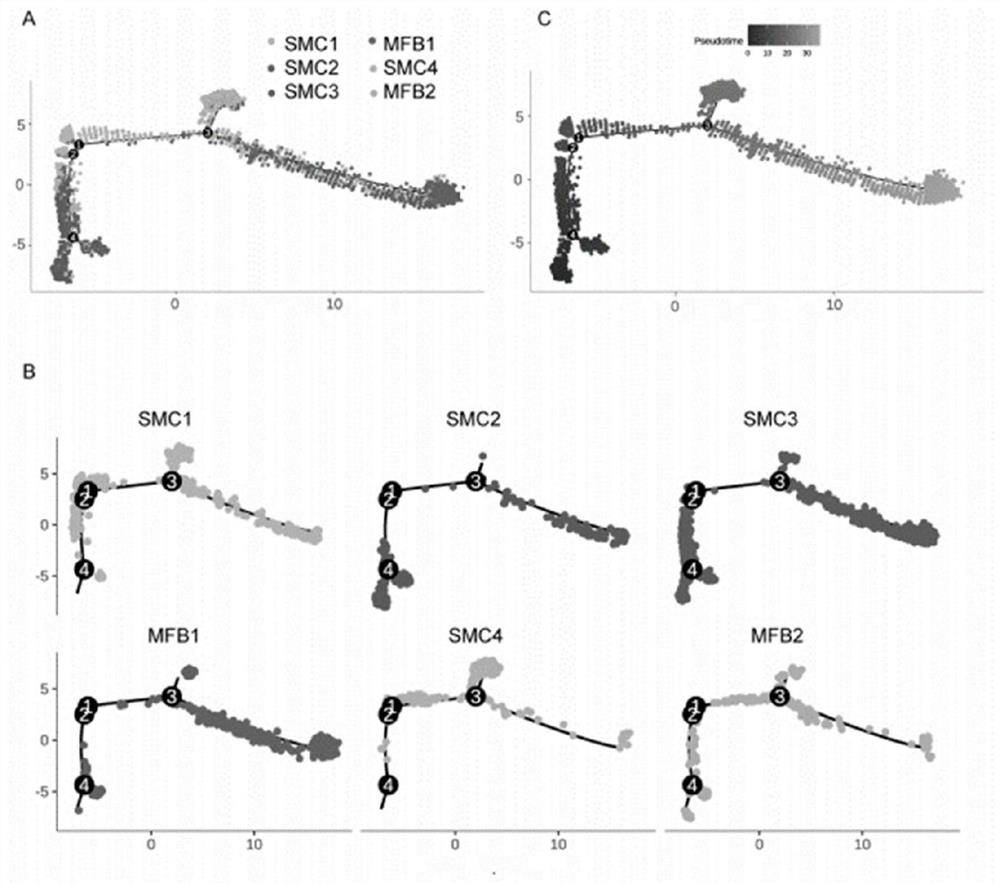Atherosclerosis-related cell marker molecules and their applications
A technology of atherosclerosis and smooth muscle cells, applied in the field of biomedicine, can solve the problem of directly responding to the dynamic change process of cell group biology, it is difficult to directly analyze the dynamic change process of each cell group, ignoring tissue structure and intercellular heterogeneity sexual issues
- Summary
- Abstract
- Description
- Claims
- Application Information
AI Technical Summary
Problems solved by technology
Method used
Image
Examples
Embodiment 1
[0118] Example 1 Single-cell sequencing of AS model animals
[0119] 1. Sample collection
[0120] Collection of large animal models of atherosclerosis ApoE - / - Arterial tissue in Beagle and WT dogs, including carotid, subclavian, aortic arch, coronary arteries, thoracic aorta, abdominal aorta, and iliac arteries. The isolated arteries were snap-frozen in liquid nitrogen and stored at -80°C for RNA extraction and Bulk RNA-seq. In addition, take part of the fresh subclavian artery and iliac artery, wash it repeatedly with pre-cooled saline, place it in a cell culture dish on ice, add RPMI 1640 cell culture medium containing 10% FBS, and use it for single cell Dissociation and scRNA-seq.
[0121] 2. RNA extraction and Bulk RNA-seq
[0122] The total tissue RNA was extracted by Trizol method, the purity of RNA was analyzed by NanoDropSpectrophotometer, and the concentration and integrity of RNA were analyzed by Agilent 2100 Bioanalyzer. After the RNA quality inspection was q...
Embodiment 2
[0142] Example 2 Single-cell sequencing of AS patients
[0143] To determine TNC high Whether the SMC3 subpopulation exists in human AS, the scRNA-seq data of human carotid artery plaques (n=3 patients) were further analyzed, and the method was the same as that in Example 1.
[0144] Human carotid plaque cells were divided into 25 clusters by unbiased clustering, and the main cell types were ECs, SMCs, MFBs, Mφ cells, T cells, B cells, and mast cells ( Figure 6 ). It was pointed out that in carotid atherosclerotic tissue specimens obtained by human carotid endarterectomy, most of the SMCs in the arterial media and the FBs in the adventitia may be lost. In human carotid plaques, the gene expression patterns of SMC-associated and MFB-associated genes (ACTA2, MYH11, TAGLN, CNN1, MYL9, TPM2, ELN, DCN, COL3A1, COL1A1, FMOD) were very similar to those in ApoE- / - dogs.
[0145] Trajectory analysis revealed intercluster relationships between SMC3 and MFB cells ( Figure 7 ). TN...
PUM
 Login to View More
Login to View More Abstract
Description
Claims
Application Information
 Login to View More
Login to View More - R&D
- Intellectual Property
- Life Sciences
- Materials
- Tech Scout
- Unparalleled Data Quality
- Higher Quality Content
- 60% Fewer Hallucinations
Browse by: Latest US Patents, China's latest patents, Technical Efficacy Thesaurus, Application Domain, Technology Topic, Popular Technical Reports.
© 2025 PatSnap. All rights reserved.Legal|Privacy policy|Modern Slavery Act Transparency Statement|Sitemap|About US| Contact US: help@patsnap.com



